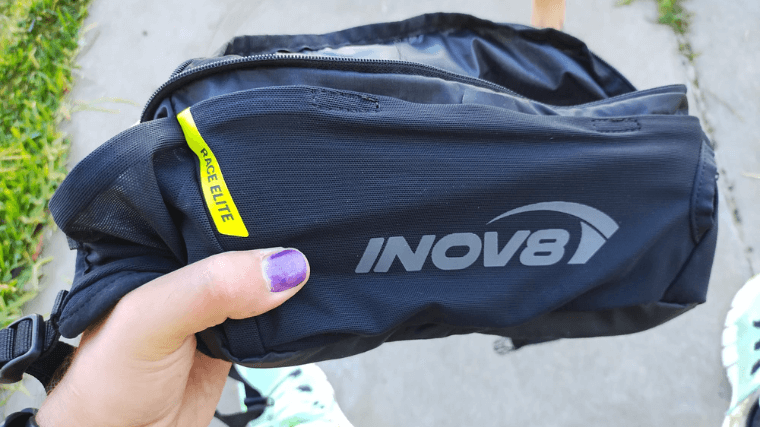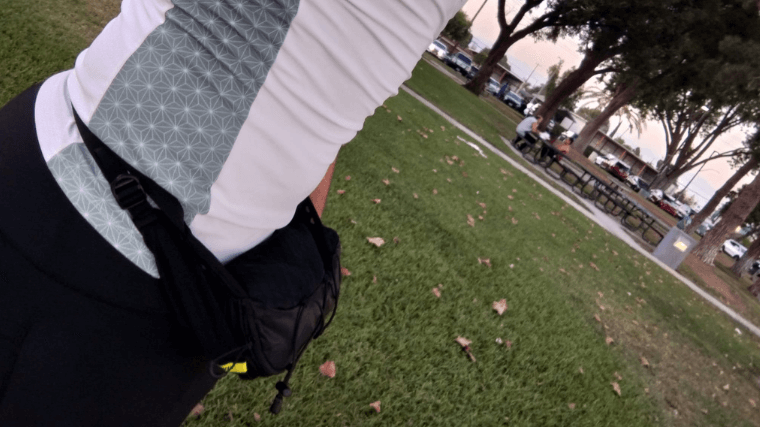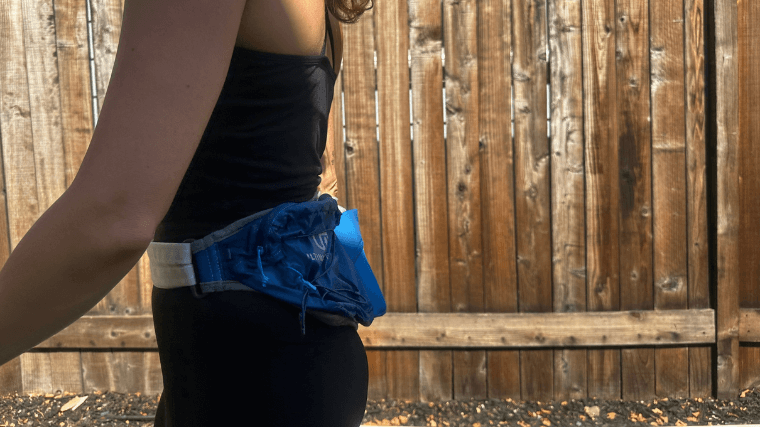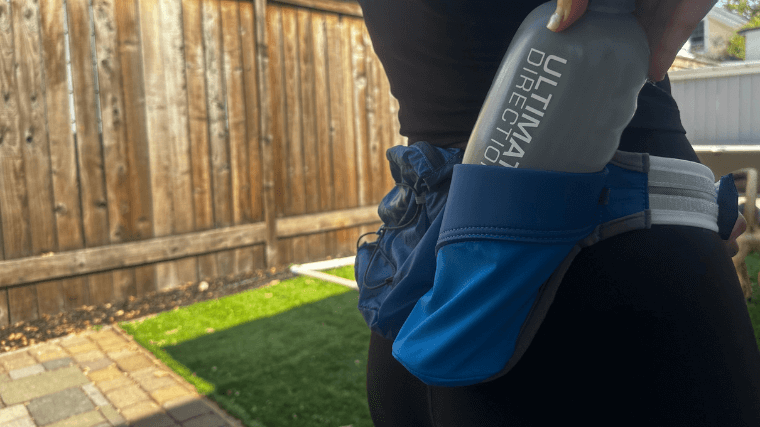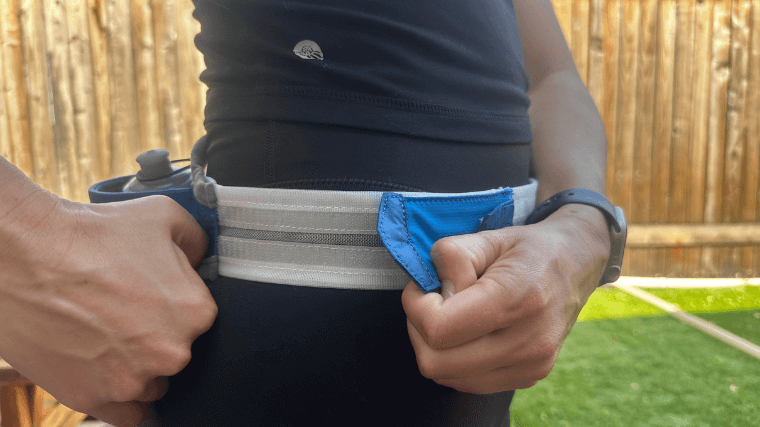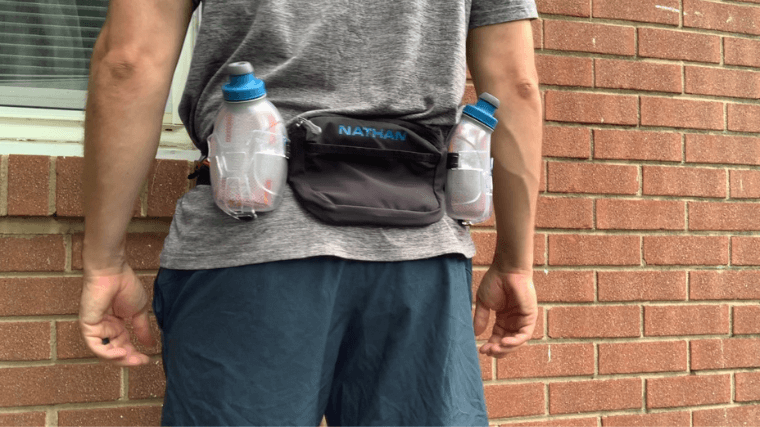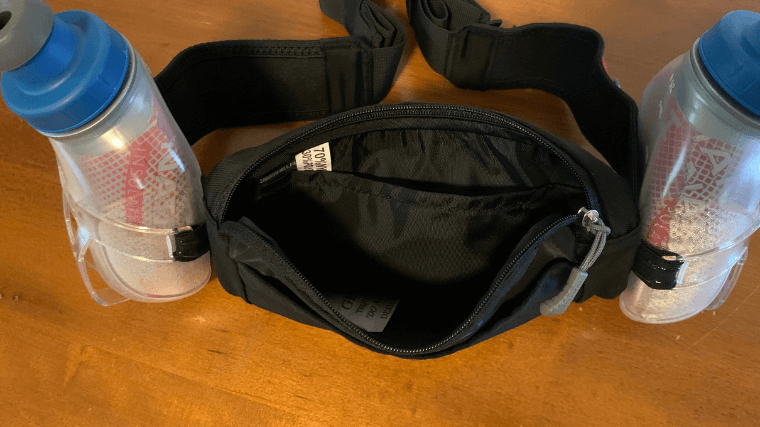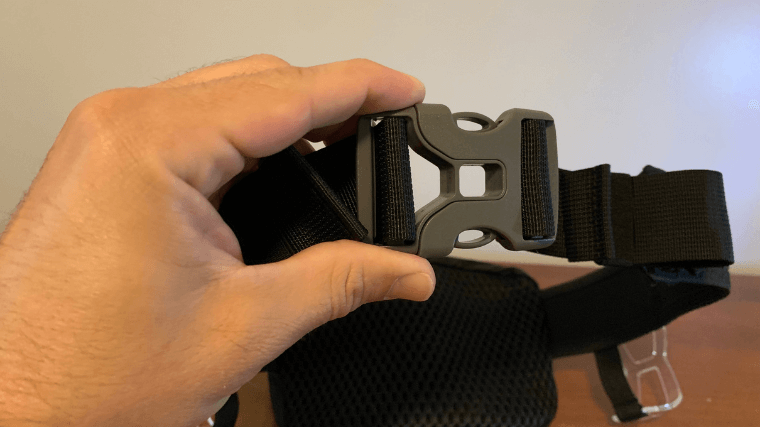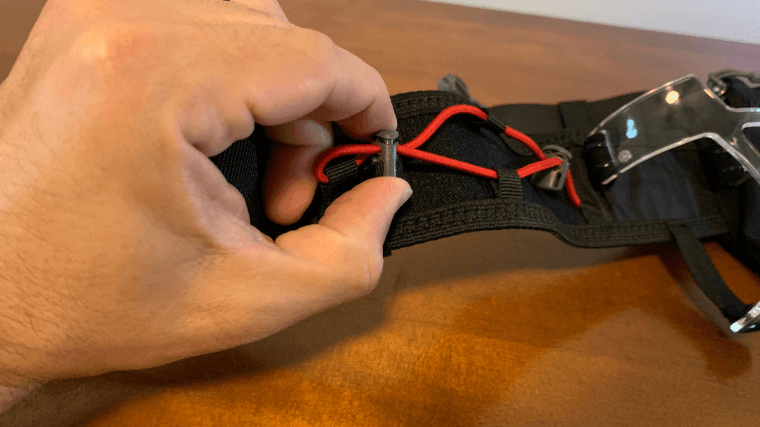Running is simple, in theory: It’s just one foot in front of the other. But if you’ve ever actually gone on a run, you know having the right running gear isn’t optional, but necessary. With a pair of the best running shoes, you’re in good shape. But you’ll probably also need a running app to track your stats and keep you from getting lost, and maybe some tunes to keep you energized. That means you’ll need your phone, including somewhere to put it — which means you could really use a running belt. (It’s all very If You Give a Mouse a Cookie.)
The good news is that shopping for a running belt isn’t too complicated or expensive. To help fast-track your search, we’ve tested nearly 20 of the best options on the market and scored our picks based on fit, durability, and more. The result is this list of the best running belts out there, all expert-approved.
The Best Running Belts of 2024
- Best Overall Running Belt: Inov-8 Race Elite Waist
- Best Budget Running Belt: New Balance Running Stretch Belt
- Best Reflective Running Belt: SPIBelt Reflective
- Best Running Belt With Storage: Ultimate Direction Mountain Belt
- Best Running Belt for Hydration: Nathan Sports TrailMix Plus 3.0
- Best Running Belt for All Body Types: Salomon Pulse
How We Tested and Chose the Best Running Belts
The BarBend team is full of athletes, certified trainers, and CrossFit coaches who’ve tested a lot of gear while logging miles. That includes sneakers, treadmills, running headphones, and — yep — running belts. Take our expert reviewer, certified personal trainer Kate Meier, for example: “I’ve been using running belts for about two decades. They have been invaluable, especially in my marathon days when I had a lot to carry with me on runs.” We’ve tried nearly 20 different running belts over the years, scoring them on a scale 1 (woof) to 5 (yay!) to arrive at these six picks. Knowing what distinguishes a good running belt from a crappy one, we kept a close eye on these key factors when compiling this list.
For more on how we test products, check out the BarBend Equipment Testing methodology.
- Materials: A running belt made with low-quality materials (or simply the wrong ones for the job) will likely jostle while you run, crumble under the elements, and allow sweat or rain to seep inside. We looked for belts made from materials that are resistant to water and sweat, breathable, and stretchy. We also considered the quality of the zippers and ripstop mesh when making our picks.
- Adjustability: Not only do you need a running belt that fits, but you also need to be able to adjust it when you’re wearing different clothing underneath or strapping in for different types of workouts. “A belt that doesn’t fit well is so annoying,” Meier says. “The constant jostling and movement of the belt is a distraction and can sometimes cause friction burns depending on where you wear it.”
- Storage: “My belt serves one main purpose: Hold my stuff,” Meier says. A running belt should have a secure pocket for your phone and keys, and for longer runs, additional space for nutrition, hydration, and extra layers may be necessary.
- Hydration Capabilities: When running a half marathon, marathon, or ultramarathon, the ability to carry hydration on a running belt is key. When making our picks, we tested belts with built-in hydration capabilities and pockets for water bottles.
Best Overall Running Belt: Inov-8 Race Elite Waist
Inov8 Race Elite Waist
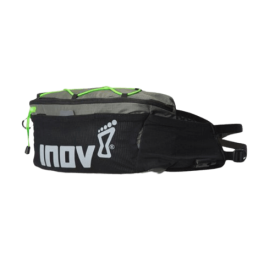
Specs
- Price: $30
- Sizes: One size
- Colors: Black
This waist belt from Inov-8 seems to have it all, including (literal) bells and whistles you probably didn’t know you needed. And somehow, it’s still one of the cheaper options on this list, coming in at just $30. This features-for-dollar ratio is exactly what makes it our pick for the best running belt overall.
Let’s start with the basics: The zippered main compartment offers a whopping 3 liters’ worth of space, including a separate pocket for a 500-milliliter soft flask. There are loops for poles and stretchy outer mesh pockets for easy-grab items, plus bungee compression straps that can be tightened when you’re not carrying much (which helps eliminate bounce) or used to secure extra layers without taking up pocket space.
“I like the combination of snaps, zipper, and Velcro to keep different sections closed. It makes it much more secure and gives me one less thing to worry about,” says Alex Polish, a BarBend editorial member and certified personal trainer who put this running belt to the test, scoring it 4 out of 5 overall.
Speaking of bounce, there shouldn’t be much of that. This is thanks to the unique dual-strap design with adjustable length and plastic buckle closure. Adjusting the straps can be a little tricky to figure out at first, but once you get the hang of it, the fit is great, Polish says, giving it a 4.5 out of 5 for comfort. “The only pain point is that my wife doesn’t really recommend it for sprinting. It’s much better for steady-state running workouts (it flops around a little too much with faster sprints).”
Polish gave the belt a solid 4 out of 5 for durability, too. The outer fabric is water resistant and the inner side is made of a breathable stretch mesh to allow for airflow. This running belt even comes with lifetime warranties on the waterproof GORE-TEX membrane and HYDRAPAK construction, plus a 12-month warranty from INOV-8. Finally, about that whistle: This running belt comes with an emergency whistle in case of emergency.
Best Budget Running Belt: New Balance Running Stretch Belt
New Balance Running Stretch Belt
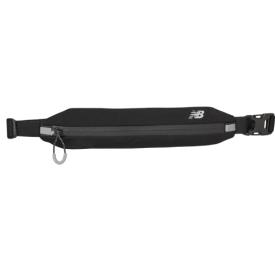
Specs
- Price: $14.99
- Sizes: One size
- Colors: Black
If you’re just getting started with running or aren’t sold on the whole belt concept yet, it can make sense to try a budget running belt first. This New Balance model is a great minimalist option; it has a single, stretchy main compartment that can fit your must-haves and costs the same as a month of Amazon Prime at $14.99.
Our tester, BarBend editorial member Matt Cummings, rated it a 3.5 out of 5 overall. The highlights? For one, this running belt is just so darn affordable — it’s probably cheaper than any other item you’ll wear to head out on a run. Also, “it’s incredibly light and small,” Cummings says, so it could be a good low-profile pick if you don’t want to feel weighed down while doing a sprint workout, but need a place to stash your keys or a credit card.
Since it’s so small, however, you can’t fit a lot inside. Cummings said he was able to fit his iPhone SE, but not much more. “I was able to squeeze my phone and keys in it, but that was about maximum capacity for this belt,” he says, giving it a 2 out of 5 for pocket size and a 3 out of 5 for functionality.
He also found that the belt can slide up while you’re running. “During my run, the strap kept riding up too far above my hips. I had to continually slide it back down to a comfortable position,” he says. Truthfully, whether or not a running belt stays put is highly personal — for example, a reviewer on the New Balance site reports no issues with it moving around. This is all to say that it can take some trial and error to see which type is most comfortable for you.
“Overall, this running belt worked fine, but it was a bit uncomfortable and the pocket is very small,” Cummings said. At such an affordable price point, it’s a worthwhile buy for beginner runners or those trying a belt for the first time.
Best Reflective Running Belt: SPIBelt Reflective
SPI Reflective Running Belt
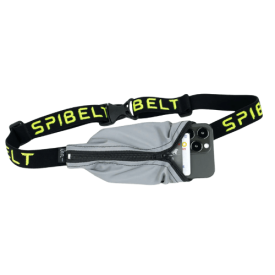
Specs
- Price: $33
- Sizes: One size
- Colors: Silver (15 non-reflective options)
Wearing reflective clothing can help you be visible while running in the morning or at night. A reflective running belt like the SPIBelt can help. (Alone, though, it likely isn’t enough; research shows that pedestrians are better perceived by drivers when they’re wearing reflective clothing on moving joints, which helps convey that it’s a human moving.) (1) Still, if you’re in the market for a running belt, it makes sense to get one that’ll keep you visible no matter what time you head out.
Certified personal trainer and BarBend editorial member Kate Meier has worn the SPIBelt Reflective for more than 20 hours of interval running workouts and gives it a 4.5 out of 5 both overall and for its functionality. “This is a fantastic belt,” she says. “I love the material, I love how snugly it fits, and it truly doesn’t move when you run.”
She scored it a 4.5 out of 5 for adjustability based on the fact that it fits waists from 25 to 38 inches — which doesn’t cover all runners, but fits many, including both her and her partner. “We have different-sized waists but we can both wear it because it’s so adjustable… he also had no issues with the belt moving or sliding, even when he ran shirtless and the belt was on his skin,” she said, scoring it a 5 out of 5 for comfort.
She adds, “The pouch itself is a soft material that feels good on your skin. The clasp is very secure, and the elastic belt is a softer material that doesn’t create unnecessary friction.” Meier also gave it a 5 out of 5 for durability, and I have to agree: I’m a fellow SPIBelt user, and my model (black, non-reflective) has lasted about eight years.
The few downsides are that it’s not water-resistant and limited in size. The SPIBelt has a single main compartment with a zipper closure, and while it’s stretchy, Meier can’t fit much more than her iPhone 15 with a case on. “So I’d recommend this only if you need to keep a phone and a key in there and nothing else,” she says.
Best Running Belt With Storage: Ultimate Direction Mountain Belt
Ultimate Direction Mountain Belt

Specs
- Price: $55
- Sizes: One size
- Colors: Black and blue
If you tend to go trail running in the mountains or train in fickle spring or fall weather, you know the importance of having an extra layer or a place to put one if you heat up. This Ultimate Direction Mountain Belt is one of the most spacious running belts we’ve seen, with plenty of storage space for whatever you need, including a light jacket, hiking poles, hydration, snacks, and more.
In addition to a large main compartment, this running belt has a dedicated pocket for the included Flexform II 500-milliliter water bottle, a front-facing key pocket, and an external bungee cord in case you need to secure anything else. Because it can hold so much, this running belt can also be a great backpack alternative for longer walks or day hikes.
Our tester, BarBend editorial member Lauren Keary, scored it a 5 out of 5 for functionality, comfort, and durability. “It held my phone, keys, and water with ease. It’s a high-quality product and there’s no fraying or visible issues that would lead me to believe it won’t last,” she says. The belt’s main compartment is made with a woven ripstop mesh to prevent any tears from spreading, and to make sure it’s breathable when sitting on your skin.
The downside there is that the mesh isn’t sweatproof, so during really hot workouts, whatever’s in the pouch may get damp. The outside, however, is water-resistant, which can help protect your phone or cash if you get caught in the rain.
The belt even has a stretchy loop to secure the best sports water bottle in your collection. Keary, though, said it can be tricky to undo while you’re on the move. “Since the water bottle sits behind you, you have to know where to feel for the loop to undo it,” she says. “Otherwise, the belt stays in place well with a secure Velcro strap, and I didn’t even experience any bouncing with the water.”
If you’re looking for a running belt that can hold plenty and doesn’t budge, this Ultimate Direction Mountain Belt could do the trick.
Best Running Belt for Hydration: Nathan Sports TrailMix Plus 3.0
Nathan Sports TrailMix Plus 3.0

Specs
- Price: $60.20
- Sizes: One size
- Colors: Black and Deep Blue
Complete with two 10-ounce water bottles and built-in holsters, this Nathan hydration belt allows you to easily carry 600-milliliters of water (or one of the best electrolyte drinks) with you on a run. That might sound like a lot of liquid to strap onto a belt, but our tester, BarBend editorial member Matt Cummings, had only great things to say, scoring it 5 out of 5 overall.
“This was an incredibly comfortable and useful running belt,” he says. “The TrailMix Plus 3.0 was way more secure and stable than I expected. Even with both water bottles full, the strap remained snug just above my hips. There is, of course, a little movement, but as far as running belts go, this is the best one I’ve ever tried.”
If anything, the bottles were a little too secure, making them slightly difficult to remove while running. “This is nitpicking because I thought the holsters were well-designed, but reaching back with one hand did require me to slow my pace a touch… It was fine taking these bottles out, but there was a little too much resistance and fiddling around for a perfect score,” he says, giving the belt a 4.5 out of 5 for functionality.
Meanwhile, it earned a perfect 5 out of 5 for both comfort and adjustability based on the storage options and great fit. “The strap is wide and there are two toggles to adjust the length, plus a band to prevent any slipping during a run. With the belt secured just above my hips, I also didn’t experience much bouncing,” he says.
In addition to the bottle holsters, there’s a zippered main compartment (large enough to fit a smartphone) with an internal divider, an outside mesh pocket, and spots to secure the best energy gels or other small items using pinch-toggle bungee cords.
One of the few downsides of this belt is that, if you’re heading out on a shorter run and don’t need two bottles’ worth of water, you can’t remove the plastic holsters and run with just the pouch.
Best Running Belt for All Body Types: Salomon Pulse
Salomon Pulse

Specs
- Price: $36.98
- Sizes: XS-XL
- Colors: Black, Gray, Red, and Yellow
Most running belts come in one size and offer an adjustable band to help you personalize the fit. This means more plastic bits that could dig in, chafe uncomfortably, or fail to hold the straps in place — but that’s not the case with the Salomon Pulse running belt. This model comes in five different sizes that accommodate waists between 25 and 41 inches, making it accessible for runners of all sizes. Unique by design, the belt is constructed as a wide, solid tube of fabric with pockets stitched inside.
That said, since this belt isn’t adjustable, it’s important that you peep Salomon’s size chart so you buy the right size. “This belt slid up my waist as I was running and walking,” says Lauren Keary, our tester and a BarBend editorial member. She scored the belt a 4 out of 5 overall, and a 3 out of 5 for comfort.
“I’d prefer a belt that I don’t have to constantly tug on during my workout. That said, I could have just not had the right size,” she says.
This Salomon belt has two horizontal pockets: one with a zipper to secure valuables, and an open-mouth easy-access pocket for things you might want to grab on the go, like gels or an sports drink. They’re large enough enough to hold a smartphone, for example, or a 500-milliliter soft hydration flask (sold separately).
The Pulse belt also has reflective details for added safety, and two diagonal elastic straps with silicone grip for securing extra clothes or poles. “It kept all of my belongings in their respective pockets, but it did move up on my waist while I was running. If you’re looking for a snug fit, I’ve tested more secure belts. However, this gets the job done,” Keary says.
As mentioned, the fit of running belts is super personal, so it’s worth noting that there are customers on Amazon who report zero movement with their belt.
Benefits of Running Belts
If you’ve done plenty of long runs, you already know how important it is to have the proper running fuel and hydration to get you through hours of pounding pavement. One of the key benefits of running belts is a place to store that grub. “I like a belt for really long runs when you know you’ll need mid-run energy boosts and hydration,” says Kate Meier, certified personal trainer and our expert reviewer. “When I was marathon training, I’d store a few running gels in my belt, which also could hold several small water bottles.” If you’re unacquainted, however, we’ll break down some of the key perks running with a belt can offer.
- Convenient Storage: Running belts allow you to bring your phone (for safety and entertainment purposes), house keys, wallet, and anything else you might need on your run. Unlike a backpack or other type of bag, a running belt is designed to fit tightly onto your body, so you don’t feel it while you run.
- Simplified Hydration: How much you should drink during a run is highly personal, but it’s essential to hydrate adequately before, during, and after runs to prevent dehydration. (2) Because running belts allow you to carry water or electrolytes with you, you can say goodbye to plotting routes around public water fountains or loops that go continuously past your car or house.
- Fewer Distractions: Many people find running belts to be the most comfortable way to hold onto their valuables while running, especially compared to the alternatives: stuffing things in pockets (where objects can jiggle or slip out), holding them in your hand, or sticking them in your sweaty sports bra (we know you’ve done it).
How Much Do Running Belts Cost?
Luckily, running belts aren’t pricey — they range from about $15 to $60. The cheaper options typically have a simpler, single-pouch design, and more expensive ones come with more storage and built-in hydration systems.
What to Consider Before Buying Running Belts
What do you really need in a running belt? “First thing I always think of is function,” says Kate Meier, certified personal trainer and our expert reviewer. “Is the belt big enough to fit what you need (phone, running gels, car key, etc.). And on top of that, is it secure enough?” Give these factors below some consideration; they’ll dictate which model might be best for you.
Fit
Most running belts are one-size-fits-most, but you’ll want to double check your own waist circumferences and compare it to the product details. Keep in mind: “Typically you wear a belt over your clothing, so the friction shouldn’t be an issue, but the sizing and adjustability is important,” Meier says. “Does it come in your size, and does it allow for micro-adjustments? I wouldn’t buy a belt that isn’t fully adjustable. First of all, on any given day, my waist size could vary due to bloating, food babies, etc. Second of all, some days you need a tight fit (maybe on speed work days when you don’t want a lot of jostling), and some days you’re fine with going a little looser.”
What Will You Be Carrying?
Do you just need a place to stash your keys? Will you bring your phone, and if so, how big is your current model? Do you hope to hold snacks or gels, water bottles or pouches, or an extra layer? Will you need an easy-to-reach compartment for poo bags or treats, if your dog tags along? Understanding your storage needs will greatly influence which type of running belt is right for you — and maybe even make you realize that one of the best running vests or arm bands would be better.
Safety
Running belts can also serve a safety purpose. “Many of them have reflective strips on them, which make you more visible in high-traffic areas,” Meier says. That’s an important feature to look for if you run early in the morning, late at night, or on busy roads or trails. “And of course, if they hold your phone, you have a way to call for emergency help,” Meier says.
Running Belts FAQs
What is the best running belt?
Our pick for the best running belt is the Inov-8 Race Elite Waist. It costs just $30, but comes with loads of features, including 3 liters of storage space, an emergency whistle, several different types of pockets, compression bungee cords, and a dual-strap belt. To boot, it’s covered by three different warranties. In terms of value, you just can’t go wrong.
Why do people wear running belts?
Many runners wear running belts to hold their phone, house or car keys, wallet, and other essentials while they run. Take it from certified personal trainer and BarBend editorial member Kate Meier, who’s been using running belts for 20 years. “I like to listen to music and podcasts when I’m out, so the belt has to hold my phone. Depending on where I’m running, it also has to hold my car key,” she says.
Should running belts be on the hips or waist?
Running belts can also be called “waist packs,” but you shouldn’t really wear one on your waist. It’s best to wear a running belt low across the widest part of your hips, just below your hip bones, with the rear pocket resting on your lower back or glutes. This ensures the belt isn’t pushing on your stomach or affecting your breathing, and helps to minimize any bouncing or sliding. It can take a bit of adjusting to find the perfect fit when you first set out on a run, so keep in mind you may need to make some small tweaks until it’s settled.
Is a running belt or backpack better?
It depends on two key factors. First is how much you need to carry; a running backpack or vest could make more sense if you need to bring lots of hydration, nutrition, or extra layers. Second is personal preference; some people find running belts annoying, while others can’t stand the feel of a running backpack or vest on their shoulders. You may need to try both out to see what you prefer — and keep in mind that one may work better for long runs or winter workouts, while the other may come in clutch while training in the heat or on the trails.
References
- Wood, J. M. (2023). Improving the conspicuity and safety of pedestrians and cyclists on night-time roads. Clinical and Experimental Optometry, 106(3), 227–237.
- Roy, Brad A. Ph.D., FACSM, FACHE. (2013). Exercise and Fluid Replacement: Brought to you by the American College of Sports Medicine. ACSM’s Health & Fitness Journal, 17(4):p 3.
The post Best Running Belts of 2024, Worn and Tested By Our Experts appeared first on BarBend.


